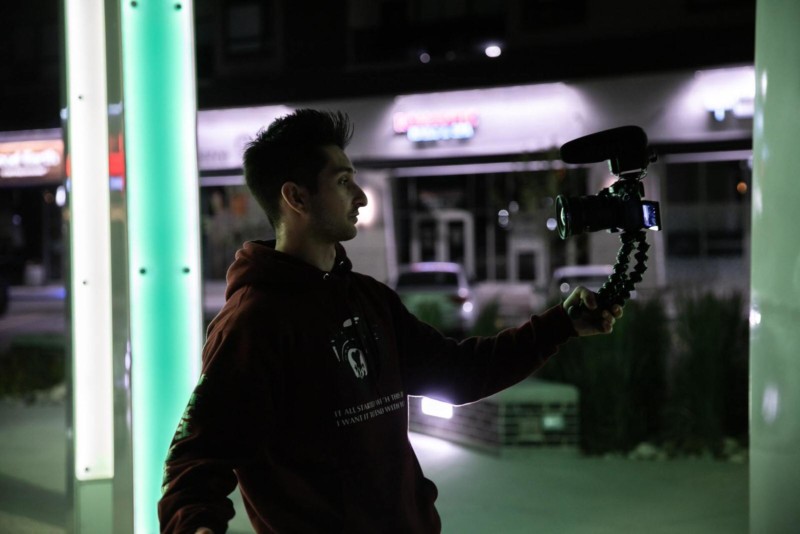![]()
You missed out on that big first wave of Instagram stardom, you jumped on YouTube too late and now your Facebook page’s dwindling audience lives exclusively in Murmansk.
You feel like your landscape photography is as good as (or better than) all these big-name photographers and you just want a slice of the cake. How can you turn your landscape photography skills into dollars?
There’s good news and there’s bad news. The good news is that it is possible to make money from landscape photography, the bad news is that there are a few hoops to jump through along the way. Here is my guide to the best way to maximize your income.
Lightroom Presets
This one’s easy. Everyone’s looking for that shortcut to a winning shot — a quick and simple way of transforming a photograph from the ordinary to the exceptional. Lightroom presets will never do that — they’re almost completely pointless — but your potential customers don’t know that!
So here’s the drill. Go and download someone else’s pack of landscape photography presets and tweak them very slightly. Now give them pretentious sounding names (such as “Attack ships on fire off the shoulder of Orion”), export them, and bundle them up. Before you stick them on Shopify always remember to give the pack an aspirational and pretentious name like “Autumn Soliloquy”. Add a couple of your better photos (they don’t need to have any relevance whatsoever to the preset pack) and you’re golden. Now watch as a parade of useless photographers queue up and demand that you, “Shut up and take my money!”
Lessons
You’d rather be out taking your own shots and picking out keepers to hang on the walls of your very own gallery, but you’ve got to pay the bills, right? This step to financial independence is the famous photographic one-to-one. You offer tuition to people with all the photographic intuition of a spatula and earn filthy lucre for whoring yourself out. It’s simple.
Simply advertise your services on your social media platforms and offer half or full-day packages, out in the landscape, where photographic novices can learn all of the secret skills such as ‘light’, ‘composition’, ‘the rule of thirds’, ‘tripods’ and ‘capturing the serenity of nature in all its glory’.
In order to make it look like these sessions are over-subscribed, remember to put the occasional post on social media saying that you have had ‘cancellations for a fully booked session’ the following weekend, but that if they are quick they can ‘secure one of the strictly limited spots’.
Calendar
Almost certainly the only way you’ll ever make actual money from your landscape photography. The photographic calendar is a mainstay of the C-List Landscape Photographer’s money-making arsenal, a guaranteed annual pay-off, and rare ray-of-hope in an otherwise bleak financial landscape.
Simply try and find 14 decent shots from the tens of thousands you took over the course of the last year and stick ’em in a Snapfish calendar template. Give it a suitably arty name, such as “Resplendent Vistas of the Artichoke Peninsula” and you’re good to go.
Remember to get them on sale by July though, it’s no use trying to sell them in December because your customers will all have bought your competitor’s effort.
Prints
Sometimes people will message you on Facebook, raving about your photography and asking you for a print of a particular photograph you took. You will excitedly go off and get a quote from your local printers and send it to the eager beaver customer and then you will never hear from them ever again. This is because nobody wants to pay any more than about $50 for a two-meter stretched canvas with a floating oak border, including delivery, and if your quote exceeds that they will simply go and buy a generic print of palm fronds from their local DIY superstore.
So if you want to make money from prints you have to dispel the notion that you are selling ‘fine art photography’, embrace the bargain basement and sell $15 prints you produced yourself on your Canon Pixma printer and framed in plain white $3 frames from K-Mart. Easy.
Stock
Nothing screams maximum-effort-minimum-return like licensing your photographs on stock libraries. All you have to do is upload your photograph, spend an hour painstakingly selecting appropriate keywords, then add a title, category, location, description, and model release and you’re good to go.
Now just repeat this several thousand times to ensure that a few make it past the stock agency’s reviewing panel. As you’ll only be earning about $0.75 for a print resolution license of your photograph, it’s important to try and get as many photos up there as possible. If you apply yourself to the task, you might earn enough in a year to buy yourself a cappuccino.



Copyright Infringement
This is one of the leading growth areas in revenue for C-List landscape photographers. As with most photographic sectors, a corporate middle-man will do better than you out of the process, but that shouldn’t stop you from pursuing this worthwhile money-making enterprise.
Simply sign up with an agency such as Pixsy or Copytrack and then add your images to their database. They will then scour the Internet searching for websites that have used your photograph and when they find an offender, alert you to the infringement. Then all you have to do is give the agency the go-ahead and they will pursue the offender and seek financial redress from them.
Unfortunately, most copyright infringement is centered in China and no agency will ever bother pursuing financial compensation from Chinese businesses as they have free rein to steal whatever they want from whomever they want and use in any way they deem necessary. Also, any image you ever uploaded to a stock library can’t be pursued. However, you will still find there are plenty of hapless idiots out there who think anything that’s online is fair game and you can sue them for all they’re worth or, you know, the market value of your shot.
YouTube
If the success of famous YouTube photographers has proven anything, it’s that looking excruciatingly uncomfortable in front of a camera is not a barrier to financial freedom. If you’re prepared to film yourself out and about taking your photographs and then spend a full day editing your video and then uploading it to YouTube, it’s possible that you might attract an audience. Spend several years building a subscriber base that climbs out of the double digits and eventually Google will deem you worthy of carrying advertising on your channel. Then just sit back and wait as the monthly payments for $10 or $15 make all those endless hours, days, and weeks of effort worthwhile.
Patreon
It’s the photographer’s dream, encapsulated in one word … Patreon. Oh, how we love you Patreon. If enough people pity you sufficiently to throw in a few bucks, it’s entirely possible to eat out once a month on the proceeds of your Patreon fund. Unfortunately, it’s also entirely possible that nobody will throw a few bucks in your direction and you’ll end up looking like that toothless harmonica player busking outside the nearest strip mall with a few coins and a button in their begging bowl.
Influencer
It’s pretty tough to become an actual influencer in this day and age. Unless you are a spectacularly beautiful young woman, then you will find it hard to achieve the sort of social media follower numbers that businesses consider influencer-grade. But do not despair!
These days there’s a thing called a “micro-influencer”. Micro-influencers are people who have crawled over enough broken glass on their hands and knees to achieve between 1,000 and 50,000 followers. That’s right — with as few as 1,000 followers on your Instagram account or 2,000 subscribers on YouTube you are officially classed as a micro-influencer. This does not mean you will be invited to stay at five-star beach resorts in the Caribbean or comped free business class seats to events and festivals. However, you might score a new set of ND filters for your camera or a cheap Chinese-made knock-off of a Fitbit watch. And who doesn’t like knock-off Fitbit watches, right?



Affiliate Links
We’ve all seen them, the little list of blue links in the description of the YouTube video, or the bullet points in the ‘My Kit’ section of a photographer’s website. They’re Amazon affiliate links and if someone clicks on that link and then buys something – you get a cut! It’s virtually free money – you’d be crazy not to!
For every successful sale you point in Jeff Bezos’s direction, you’ll earn an amazing 4% of the purchase price, after taxes and deductions. So if someone buys a $2,000 camera within 24 hours of clicking on your link, you’ll get $80. How good is that? So get yourself an account and include a load of links to very expensive equipment that you ‘recommend’. Make sure you don’t put that list on an About Me page on your website which no-one apart from your mum’s ever looked at – preferably stick it somewhere click-baity that you can generate a ton of views on. Maybe reach out to a young female bikini influencer, do a travel photo-shoot at a scenic location and refer to the camera equipment that made the photos possible with links to your Amazon affiliate account. Easy money.
Blogging
The key to earning money from blogging is to lie through your teeth. People don’t want to hear the truth, they want to hear pipe dreams. Articles that do well on photography blogs tend to be ones that suggest it’s possible to earn a living from landscape photography. So go with things like, “How I Earn $200,000 a year from landscape photography” or “How I Made $50,000 in a Year from Calendars” and then pull a load of made-up facts and figures straight out of your a**. The reader will have no way of checking their veracity and you can clean-up with all those lovely AdSense dollars and affiliate links.
Easy Money
Being a C-List landscape photographer is to accept a life of graft and solitude, but with diligence and perseverance, it is possible to earn a salary comparable to that of a French fry attendant in a fast-food restaurant or an entry-level call center operative for an insurance company.
Maximize the income streams available to you, never pass up an opportunity to shill yourself, and moderate success in a tightly-defined local region will surely come to you.
Author’s note: This is a self-own and a bit of fun. I am a proud C-list landscape photographer, so please don’t doxx me and leave angry comments just because my little article rang true.
About the author: Andy Hutchinson is a photographer and journalist based in South Coast, New South Wales, Australia. The opinions expressed in this article are solely those of the author. You can find more of his work and words on his website, or by following him on Facebook and Instagram. This article was also published here.











